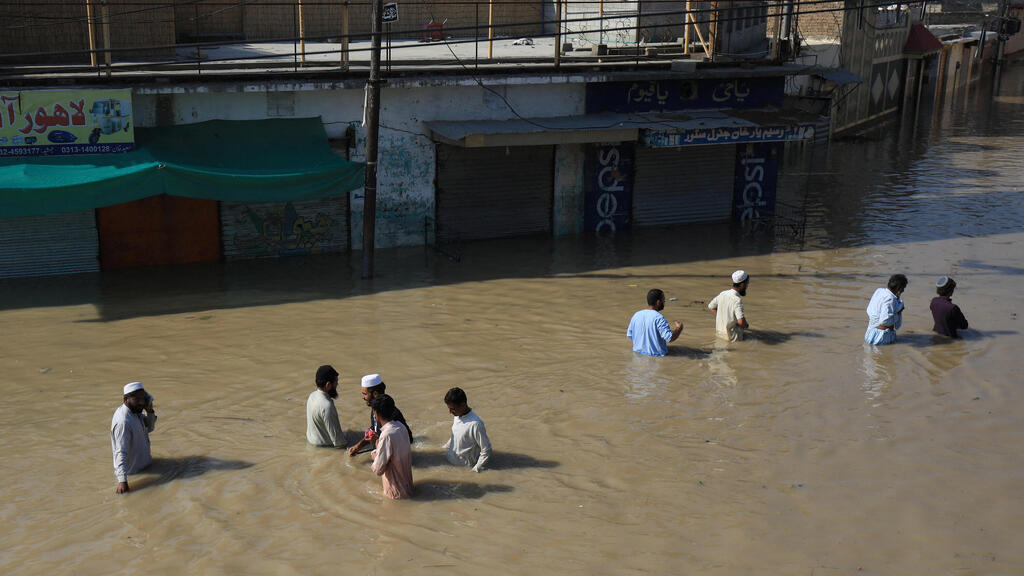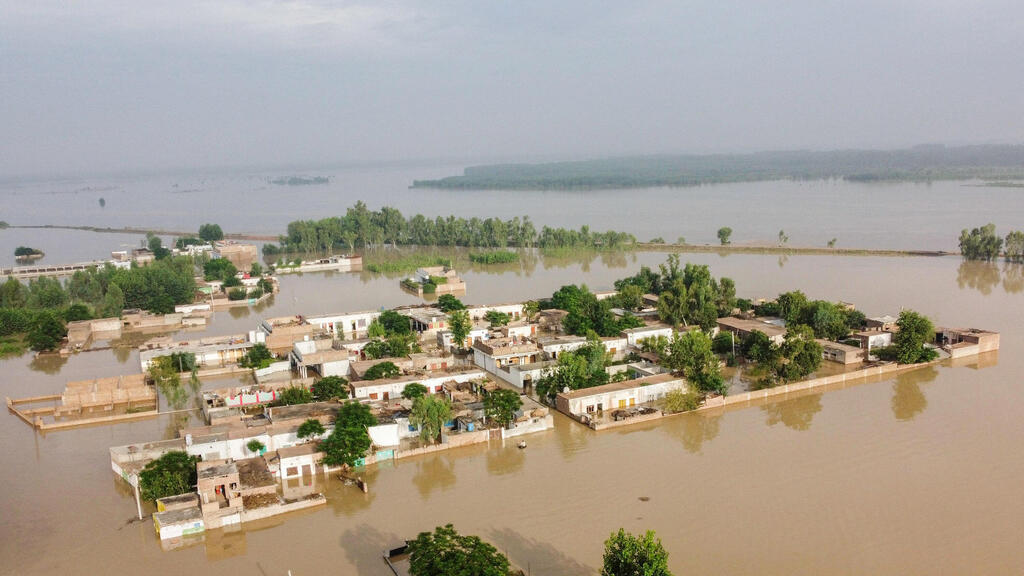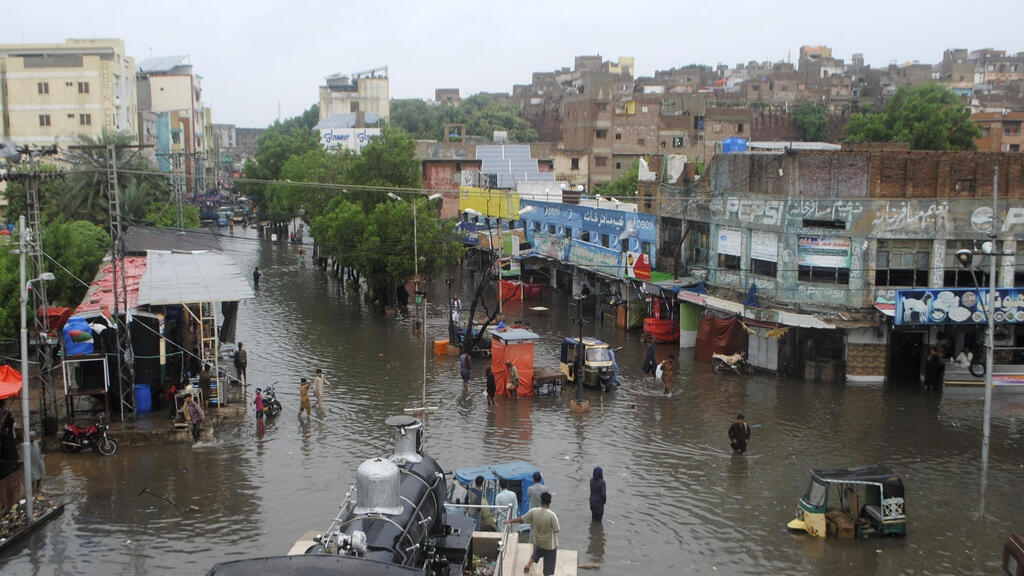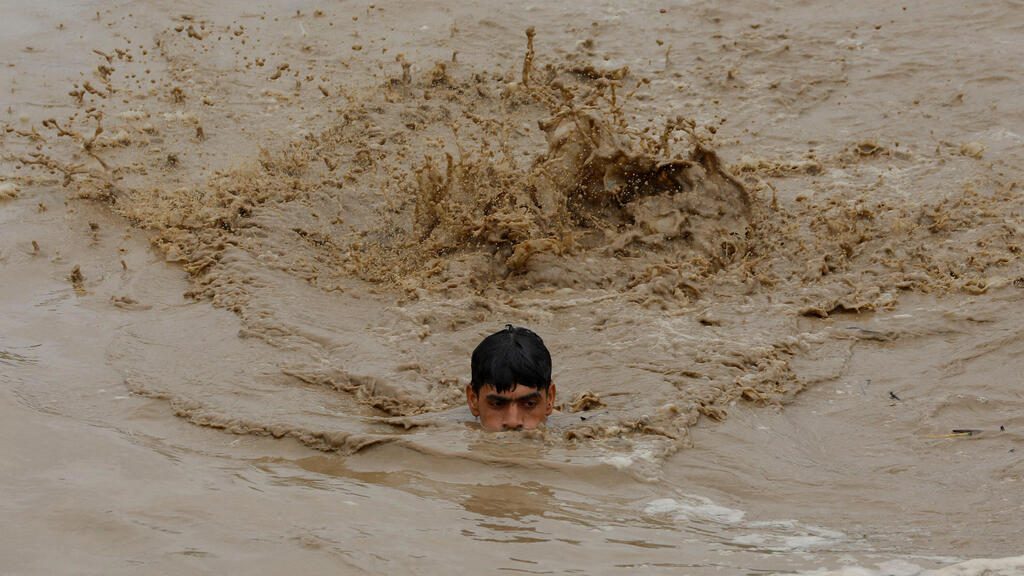Over 1,100 people have died and 33 million have fled their homes in what appears to be the worst monsoon season in decades, the Pakistani government said.
The United Nations on Tuesday appealed for $160 million in humanitarian aid following mass flooding in several regions, including Punjab, Balochistan, Sindh and Khyber Pakhtunkhwa. Between one million and two million livestock animals have died, and millions of acres of agricultural land are under water.
5 View gallery
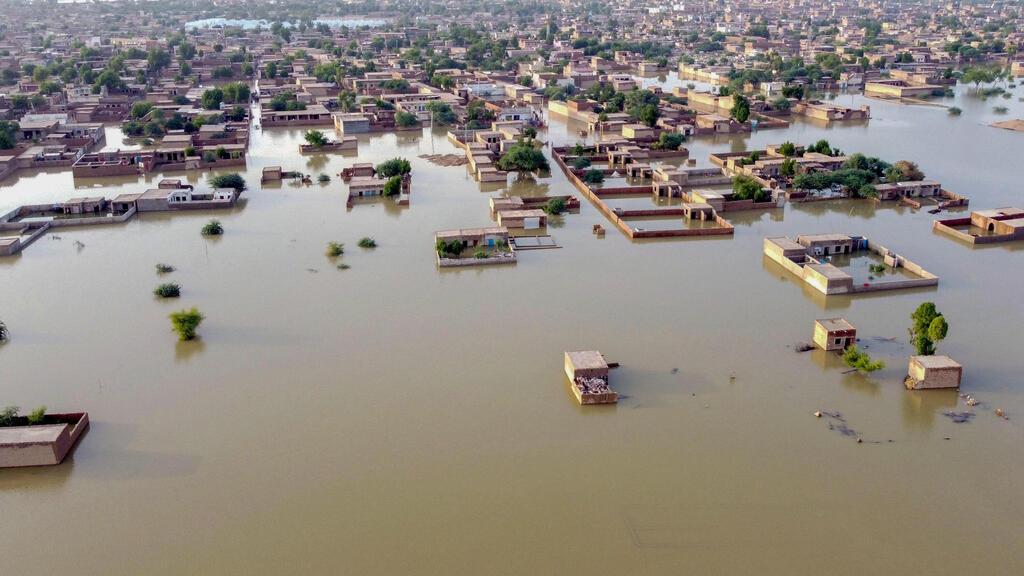

Monster monsoon submerges entire cities, in Balochistan Province, Pakistan
(Photo: AFP)
The floods in Balochistan Province were caused by glacier melt, a local rescue team manager said.
The monsoons bring heavy rains that are vital for Pakistan’s agriculture-heavy economy, but when they become too strong infrastructures collapse and floods occur. The Pakistani military along with national and international aid organizations is trying to reach flood-hit areas and rescue survivors.
“There’s water everywhere. People climb trees trying to escape, animals drown. There are bodies floating in the water. It’s very hard, and I wish I could express in English how difficult it is, but I simply don’t have the words,” Abrar Ul Haq, chairman of the Pakistan Red Crescent Society, said.
“I don’t remember a catastrophe this big. We will need to invent a new word to describe it, because ‘floods’ just doesn’t express it,” he said.
Ul Haq said from Islamabad more about the details of the crisis hitting Pakistan.
“The situation is terrible, and the monsoon only continues. We try to help where we can, but our ability is tiny when you compare it to the scale of the catastrophe. We are present in 23 districts, while over 100 districts are under water. One-third of the country is flooded,” he said.
The challenges in providing aid, he explains, are only growing.
“Thirty-three million people are displaced, and many are out of reach. Roads are under water, and only helicopters, which we don’t have, can reach most places. There are small islands where people gather and wait, but there is no electricity and therefore no communication, so we can’t even get their calls for help,” Ul Haq said.
Ihtisham Khaliq, a manager at the Alkhidmat Foundation Pakistan, took part in rescue efforts over the past few days, and he too describes a humanitarian disaster.
“We had bad floods in 2010 [when a total of 1,985 people died], but never something like this. Almost all of Pakistan is affected by this, but underdeveloped areas have it the worst,” he said.
The Foundation “works on two levels. The first one is trying to rescue people from the water. We use boats, horses and, many times, the shoulders of our volunteers to grab people and transfer them to the safe side of the floods,” said Khaliq.
Alkhidmat’s Twitter account shows rescue videos, where people improvise flotation devices to escape the waters.
“The other level is trying to supply relief to people,” continued Khaliq. “We try to provide flood-hit areas with kitchens and cooked food, as famine is one of the major risks. We also provide shelters – we built 2,000 tents all over the country for people who lost their homes.”
As six million people are estimated to have lost their homes to the floods, providing shelter is one of the most pressing needs. A food crisis is also expected, as the floods destroyed huge areas of onion and tomato fields, destroying basic ingredients in the Pakistani kitchen.
Food prices in Pakistan rose by nearly 40% in the last two days, and the government is considering importing vegetables from arch-enemy India.
The floods are creating a health crisis as well. Many of the refugees are in densely populated areas with no surviving infrastructure, and are exposed to contaminated water.
“One very big challenge we have is that many people lost access to potable water,” Ul Haq said. “What we need more than anything is disinfection kits for water. Norway helped us with kits that could help around 10,000 families.”
The Red Crescent Society head added a request for help: “We want to ask the Red Cross of America to help us. America has always been a friend of ours, and we need its help now.”
Khaliq also emphasized the developing danger.
“In areas where the water level has gone down, we try to provide medical care. Big masses of people near untreated water sources could very easily start to have infectious diseases, and we already see that starting to happen. The most common disease we see is diarrhea, and it’s already starting to spread,” he said.
The biggest challenge ahead of Pakistan, said Khaliq, will be to rehabilitate the millions who lost their homes. At least 1.5 million houses will have to be built, but that can only happen after the monsoons end and the weather stabilizes. That will take at least another month, he said.
“What worries me most are the shops and livestock gone with the water. People lost their entire livelihood, and that’s not something you can just buy back. They have nothing,” Ul Haq said.
“Suicides already started. We try to provide psychological support for people in trauma, and there are many: kids who watched their family members drown, and many others,” he added.
While the rescue forces race against time to save people, many are still out of reach, meaning the real number of victims is higher than the official estimate.
“The areas hardest hit are the remote ones. In many places the road is under water and there is no access to them. When people arrive to a city after they fled from the danger, we can try to help them, but so many are stuck in places we just can’t reach. We’re making efforts to arrive there as well, but it might take time,” Khaliq said.
Ul Haq and Khaliq agree that Pakistan is desperate for any aid it can get, but most of all it needs financial assistance.
“The most important thing for Pakistan right now is financial aid. We need international attention and aid because what’s happening here is really a catastrophe,” Khaliq said.
“I want to ask people to make any donation they can, for a year ahead. Even two or three dollars every month, for a year, would help us,” Ul Haq said.


